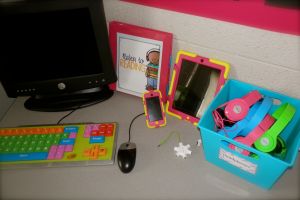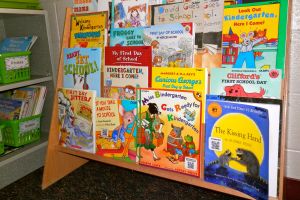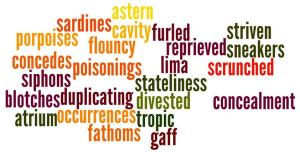My preschooler is to blame for my new classroom listening center. She really is. She’s enamored with QR codes. While strolling through the grocery store or climbing the stairs at the doctor’s office , she’ll suddenly stop and yell, “QR code,” as loud as she possibly can upon glimpsing even the faintest little black square. No kidding. It’s beyond alarming and makes me jump every time!
the stairs at the doctor’s office , she’ll suddenly stop and yell, “QR code,” as loud as she possibly can upon glimpsing even the faintest little black square. No kidding. It’s beyond alarming and makes me jump every time!
I guess that’s what we get for showing her how magical these little quick response codes really are. No QR code is safe when she’s around! Her first QR code was on the back of a box of Lincoln Logs. Then she graduated to a QR code freebie posted by the The QR Queens that allowed her to scan her favorite Christmas songs and videos on demand without the help of Mom and Dad. And by the time she was three and we visited the Fairhaven Historic District near Bellingham, WA – where tourists can take a self-guided tour of the town just by scanning QR codes on the ground – she was hooked.
So if she was hooked, it only made sense to me that emergent kindergarten readers would be just as engaged. QR codes allow students to independently access content before they can even write and read themselves. Talk about empowering! Our classroom listening center contains one student iPad and one student iPod Touch as well as Belkin’s Rockstar splitter which allows up to five students to listen to the same recording or video. Students have the option of browsing through our Listen to Reading Binder for a book of their choice and then scanning the associated QR code. I spent time this summer placing QR codes on the cover of popular books in my classroom library as well. It was a bit time consuming, but so much easier than fumbling with compact discs and tape recorders!
 One of the best Listening Center resources I’ve found is Barnes & Noble’s Online Storytime. Periodically, B&N posts a short video of a celebrity reading a favorite picture book. I was able to create QR codes for all of the stories currently posted and have made them available for free download in Google Docs. — Nook Storytime Classics QR Code Freebie
One of the best Listening Center resources I’ve found is Barnes & Noble’s Online Storytime. Periodically, B&N posts a short video of a celebrity reading a favorite picture book. I was able to create QR codes for all of the stories currently posted and have made them available for free download in Google Docs. — Nook Storytime Classics QR Code Freebie
If you’d like to try your hand at creating QR codes for your own library, I suggest using SafeShare prior to using a QR code generator such as QR Stuff to create your QR code. SafeShare eliminates any unwanted advertisements from videos as well as protects students from clicking on inappropriate content.
CCSS – SL.K.2. Confirm understanding of a text read aloud or information presented orally or through other media by asking and answering questions about key details and requesting clarification if something is not
understood.




 Can you identify the words in this word cloud taken from Ernest Hemingway’s
Can you identify the words in this word cloud taken from Ernest Hemingway’s 


